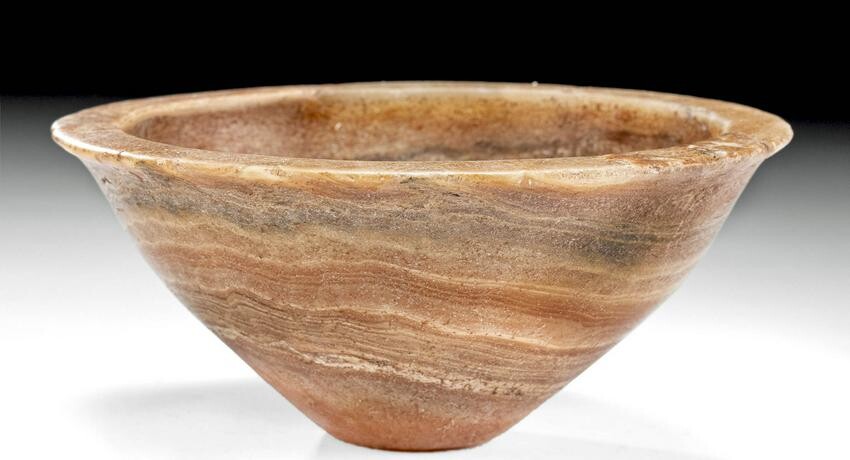Bactrian / BMAC Banded Alabaster Shallow Bowl
Central Asia, modern day Pakistan / Afghanistan, Bactria (Bactria-Margiana / BMAC), ca. 3rd to 2nd millennium BCE. A gorgeous shallow dish carved from alabaster on a small circular textured base with thin walls expanding outward to a rounded body and flared rim. Naturally adorned in bands of caramel, sand, buff, and cream, this stunning bowl boasts a lovely iridescence in the sunlight. Alabaster, a light-colored, calcareous stone from the Iranian Plateau, has strong connections in ancient western and central Asia to religion. For example, in the site of Kultepe-Kanes, a huge burial mound, there were many disc-shaped alabaster idols, naked alabaster goddesses, and lion figures. We also know that alabaster was a precious material, widely traded in the region from the 4th millennium BCE onward. A dish like this one was likely made to be placed into a tomb to hold offerings. A beautiful vessel from early Bactria! Size: 6.26" W x 3.125" H (15.9 cm x 7.9 cm)
Provenance: Paul Henderson collection, Los Angeles, California USA from the private Oxford collection; previously in an old British collection, formed in the 1980s on the UK / International art markets
All items legal to buy/sell under U.S. Statute covering cultural patrimony Code 2600, CHAPTER 14, and are guaranteed to be as described or your money back.
A Certificate of Authenticity will accompany all winning bids.
We ship worldwide to most countries and handle all shipping in-house for your convenience.
#159521
Condition Report: A few internal stable hairline fissures, nicks, chips, and abrasions, most notably on rim, commensurate with age and use. Otherwise, intact and excellent.
View it on
Estimate
Time, Location
Auction House
Central Asia, modern day Pakistan / Afghanistan, Bactria (Bactria-Margiana / BMAC), ca. 3rd to 2nd millennium BCE. A gorgeous shallow dish carved from alabaster on a small circular textured base with thin walls expanding outward to a rounded body and flared rim. Naturally adorned in bands of caramel, sand, buff, and cream, this stunning bowl boasts a lovely iridescence in the sunlight. Alabaster, a light-colored, calcareous stone from the Iranian Plateau, has strong connections in ancient western and central Asia to religion. For example, in the site of Kultepe-Kanes, a huge burial mound, there were many disc-shaped alabaster idols, naked alabaster goddesses, and lion figures. We also know that alabaster was a precious material, widely traded in the region from the 4th millennium BCE onward. A dish like this one was likely made to be placed into a tomb to hold offerings. A beautiful vessel from early Bactria! Size: 6.26" W x 3.125" H (15.9 cm x 7.9 cm)
Provenance: Paul Henderson collection, Los Angeles, California USA from the private Oxford collection; previously in an old British collection, formed in the 1980s on the UK / International art markets
All items legal to buy/sell under U.S. Statute covering cultural patrimony Code 2600, CHAPTER 14, and are guaranteed to be as described or your money back.
A Certificate of Authenticity will accompany all winning bids.
We ship worldwide to most countries and handle all shipping in-house for your convenience.
#159521
Condition Report: A few internal stable hairline fissures, nicks, chips, and abrasions, most notably on rim, commensurate with age and use. Otherwise, intact and excellent.



